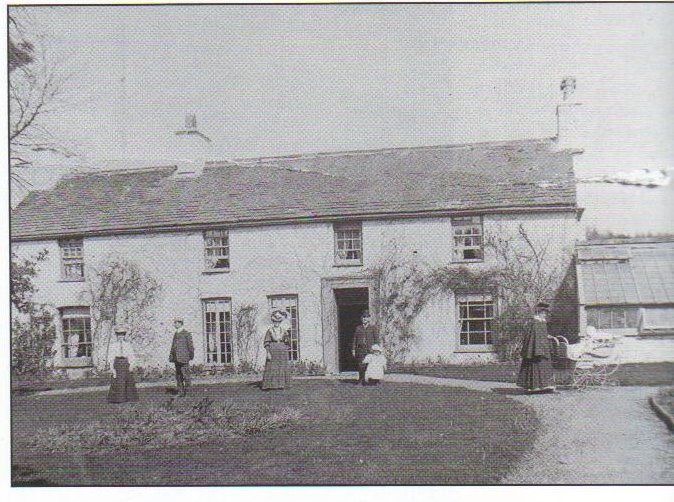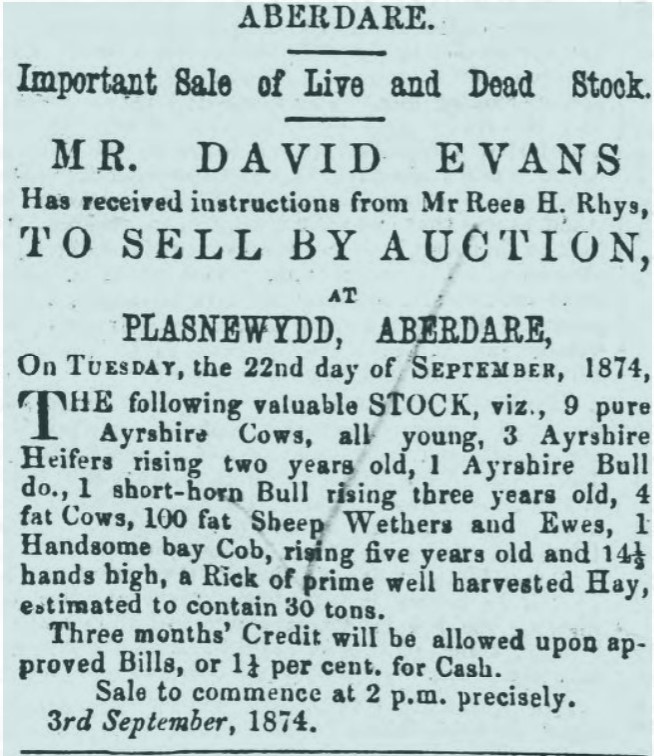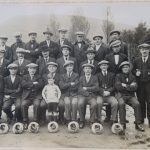A marble bust, the face stern and uncompromising, yet of lonely countenance, looks out from the public health display case in the museum’s gallery.
The bust’s true to life likeness is that of Rees Hopkin Rhys, known as ‘Blind Rhys’, whose long career needs to be chronicled in detail. Until this happens, however, this brief biography will have to suffice. Despite his paramount importance in local affairs, his name does not even appear as an entry in the Dictionary of Welsh Biography.
The bust is a copy of one executed by the eminent sculptor Sir Thomas Brock RA (who also created the statue of Lord Merthyr in Aberdare Park) in 1881 for the Board of Health’s Meeting Room in Merthyr Tydfil.

Image produced by CVM.
Rees Hopkin Rhys (1819 – 1899)
Rees Hopkin Rhys was born at Llwydcoed House, Aberdare in 1818. He was the second surviving son of Jenkin Rhys, principal agent to the Aberdare Iron Company.

Llwydcoed House, the birthplace of Rees Hopkin Rhys (Image owned by Geoffrey Evans).
Even before he was 20 years of age R. H. Rhys was reputed to be well versed in local and parochial matters. Later in life, his ready knowledge of the workings of the Poor Law and technicalities connected with local administrative boards was proverbial and surprising (Cardiff Times, 19th August 1899).
In June 1847 as a young Aberdare mineral agent assisting his father, Rees Hopkin Rhys attended a demonstration of the properties of the explosive gun cotton at the Dowlais Lime Quarry. One of the experimental charges was too large for the prepared borehole, so the demonstrator removed the gun cotton from its cartridge in order to ram it into the bore. The removed loose gun cotton was packed into the borehole and then tamped down with an iron ramrod and in the process, the rod struck the rock inducing a spark that ignited the gun cotton. It exploded, generating a cloud of limestone fragments, and Rhys, who was, unfortunately, standing close to the source, received the force of the blast. The fragments impacted his face and he was instantly deprived of his sight; he was then just 28 years old. (The facts of the accident are as presented at the Glamorganshire Assizes. See below)
The best medical attention in London and Bristol was sought, but nothing could be done to restore any sight. For two months afterward, he was confined to his bed. The explosion had also caused several wounds, but the major irritation was the constant inflammation of his eyes.
Rhys brought an action for negligence against the demonstrator, Messrs. Hall, and another, gun cotton trader. The case, which was defended, was heard before a jury at the Glamorganshire Spring Assizes and held in Swansea in March 1850. After hearing the evidence the court found in favour of Rhys and awarded him damages of £1,500 [£207,000 today] (Cardiff and Merthyr Guardian, 16th, March 1850).
Such a disability and its psychological effects would have caused most men to become a recluse (he had the means), but not Rhys. As the Evening Express commented ‘….. [the disaster] seemed to give him new energy’ (14th August 1899). Fifty-one years later he was to describe the loss of his eyesight as ‘a great disappointment to me’ (Ibid 31st May 1898).
By 1866, he had moved to Plasnewydd, Llwydcoed into the mansion built by the ironmaster, William Watkin Wayne.

Plasnewydd, Llwydcoed (Image owned by Geoffrey Evans)
In the 1851 Census, he describes himself as a ‘mineral surveyor (blind).’
Despite a complete loss of his sight, he devoted himself to complex civic matters which proved to be of great benefit to Aberdare. As a commemorative tablet in the parish church of Aberdare records:
By his great ability, foresight, and strength of character, he proved himself to be one of the ablest public servants of the nineteenth century.
A remarkable eulogy, even allowing for the excessively flowery praise of the age.

A young Rees Hopkin Rhys. (Sketch, Cardiff Times, 19th August 1899)
His greatest achievements were, most likely, the acquisition of the park and its laying out, although he is not particularly remembered for this, as well as the setting up of a local Industrial School in 1877, then a progressive almost revolutionary step, and a model since copied by many other Guardian administrations (Glamorgan Free Press). In 1895 the schools were renamed Training Schools. In these boarding schools poor, neglected, and workhouse children who were in mortal danger were provided with basic literacy and trained for a useful trade.
Trawl through the pages of the Aberdare Times (from 1861), and other local papers, however, and very few editions fail to mention him in one of his many capacities. Uniquely, he served as Chairman of the local Board of Health, Merthyr Board of Guardians, the Burial Board, the School Board (1874), and The Aberdare Urban District Council (1894) of which he was the first Chairman. In addition, he regularly sat as a magistrate at Merthyr, Aberdare, and Penderyn having been appointed Justice of the Peace in 1867. His duties as a local magistrate also required him to attend Quarter Sessions which were held at various locations in the old county of Glamorgan. He also became one of the first members of the Glamorgan County Council (1889), standing as a Conservative in the Llwydcoed Ward of Aberdare, winning the seat by just 59 votes. The other candidate was a Liberal, Griffith George. He was also a colliery proprietor employing 245 men and 94 boys*. He farmed 64 acres at Plasnewydd, Llwydcoed, and elsewhere (1861 Census). Where did he find the time?

Rhys’ farming activities. Advert: Aberdare Times
He does seem to have had some practical help from his unmarried sister, Mary; according to her obituary in 1866, she acted as his amanuensis for years (Cardiff Times, 5th June 1886). On public duties, reports show that he was escorted around and accompanied by a local police officer. An entry in the diary of Police Constable Dagg ( 6th September 1881) says that Dagg took R H Rhys Esq from Aberdare to the Industrial School. Other entries show Dagg assisted Rhys in haymaking at Plasnewydd. The diary is at Glamorgan Archives (D/D Con.183)
He was and still is, known as ‘Blind Rhys’; whether this term is one of endearment or pejorative, it is hard to determine. It is certain that no one ever referred to him as such in his presence.
What he achieved for Aberdare and Merthyr and indeed the old County of Glamorgan is well documented, but it is more difficult to assess his personality. One would have to read every newspaper report of Board of Health and School Board meetings and the proceedings in the police courts, where he often chaired the bench, to establish this.
He was undoubtedly a patrician and a man who would brook no opposition. Obituaries in The Glamorgan Free Press and other newspapers recorded that he ruled Aberdare local affairs with absolutism, autocratic in its command of obedience, but for the public good. Aberdare, the paper said, was, as the result of his stewardship, an ideal township in the material side of its parochialism. We forgive autocracy, continued the paper, when we view its results and when we realise that it was accompanied by a capacity for local administration as shown by him (19th August 1899).
In May 1857 Rhys was fined 10/- (50 pence) and costs for assaulting the Llwydcoed station master following a row over an allegation that the railway employee had sent the Merthyr train off early, stranding his (Rhys’) guests. The evidence adduced was that Rhys had struck the station master across the shoulders with his walking stick with such force that the stick broke in two. Rhys then prodded him with one of the broken pieces.
A decade later he was appointed a Magistrate. In 1877 he fined himself 5/- (25 pence) and costs for allowing his dog to stray. He could not, he said, in all consciousness fine other people for this offense unless he dealt the same measure to himself. (Aberdare Times, 27th July). The following year he publicly apologised to the Police Superintendent for remarks made in court (AT 29th June). That same month in court he constantly interrupted Aberdare solicitor, William Beddoe.
As chairman of the School Board in 1880, he showed blatant prejudice in the case of two young Jewish girls who were applying for posts as pupil teachers. It was a requirement of assessment that candidates should attend for an interview, but he insisted, despite reasonable representation, that they attend on the customary Saturday which was the Jewish Sabbath. In an article in support of the Jewish applicants, The South Wales Daily News daringly declared that ‘the gentleman is a law unto himself…his intolerance is proverbial wherever his name is known.’ The girls’ father was obliged to appeal to the Government and they were eventually granted an interview on an alternative day. (For a full account see South Wales Daily News, 9th August 1880)
In 1898 he publicly clashed with the genial Stipendiary Magistrate (a paid professional lawyer), Mr. W M North, during a court hearing. North objected to Rhys stating a material fact on behalf of a defendant in a case being heard and told him not to intervene. Rhys angrily interjected, ‘Don’t dare to tell me I have no right to interfere. I have a right to interfere’. The Stipendiary replied ‘I don’t say so. After 12 years experience on this bench, I ought to know!’ There are other incidents of him crossing local solicitors and interrupting evidence giving and proceedings.
Nevertheless, in May 1898, some of the ratepayers of Aberdare and Merthyr Tydfil, ‘as a slight recognition of his long and invaluable public services’ presented Rhys with a monogrammed antiqued silver salver, an album containing a public address, a photograph of the bust now in the gallery and a purse contain £1,000 guineas. (Equivalent to some £134,000 today.)
The address setting out the major civic achievements of the recipient recorded that he had:
- Served as chair of the Board of Health and District Council thirty-three consecutive times and taken a leading part in the administration of their affairs.
- Had overseen the installation of a (then) up-to-date sanitary system at an economical outlay.
- Secured a people’s park for the town which is the pride of the inhabitants and unique in colliery districts.

Members and officers of the first Aberdare UDC. Rees is in the centre of those seated. (Image reproduced with kind permission from RCT Library Services).
Out of a period of twenty-seven years he served for twenty-four years as a member and twenty-one years as Chairman of the Aberdare School Board. During that period 15 schools were built providing accommodation for over 6,000 children.
Yet his obituary in the Glamorgan Free Press is at odds with this statement, writing that there had been no progress in Aberdare in this field under his watch. It was, it contended, a subject he was not enthusiastic about; in fact, in its opinion, School Board Membership was the failure of his life and it was a mistake that he had sought it.
Rhys had been one of the most active magistrates in the County. He had served on most of the county committees, resulting in considerable benefit to the ratepayers of the county, especially to those of the Merthyr Tydfil Union.
Rhys died at his home at Plasnewydd on the 13th August 1899 of cardiac failure precipitated by asthma, after a long and active life that had spanned the introduction of the new Poor Law, outbreaks of cholera, the introduction of a Board of Health, and many other social changes.

By his great ability, foresight, and strength of character, he proved himself one of the ablest public servants of the nineteenth century – the opinion of Sir W T Lewis Bt. (later Lord Merthyr) who set up this tablet in the parish church. {Image RCTCBC Digital Archive
I shall conclude this article with the opinion of a contemporary Welsh newspaper . . . ‘But there are spots on the sun. There are none who are perfect, and, though regretting this fault [his record in educational matters], we still uphold this brilliant man as an example and a model in local public service to his parish, his union, and his county.’ (Glamorgan Free Press, 19th, August 1899).
Rhys, who was unmarried, is buried in the family vault in the graveyard of Penderyn Church. He was a Unitarian (although not a practicing one) and a Freemason. Rhys was the brother-in-law of William Menelaus, work’s manager, Dowlais ironworks.

Sic Transit Gloria Mundi. The neglected Rhys family vault, Penderyn church. (Photo, courtesy Mrs Celia Morgan, Penderyn).
*Messrs Rhys & Co, Merthyr Dare Colliery, Cwmdare. (Acquired July 1860)
Rees Hopkin Rhys: A Note on Sources
Although acknowledged as one of the ablest public servants of the nineteenth century, possessing great ability, foresight and strength of character (Lord Merthyr) there is no published monograph relating to his life and times, nor indeed a chapter or section in any historical journal. His omission from The Dictionary of Welsh Bibliography is inexplicable.
The sources of this brief article are cited in the text. The principal primary sources consist of (1) the Minutes of the Aberdare Local Board of Health (Ref.LBA), School Board (DX/38/1/1-10 and DX38/3/1-3), the Merthyr Tydfil Board of Guardians (Ref.UM), The Minutes of the various Boards are held at Glamorgan Archives, and (2) the local newspapers which reported on the proceedings of the various Boards, particularly the Aberdare Times and the Merthyr Telegraph and General Advertiser, Merthyr Express, Western Mail and South Wales Daily Post, upon which I have drawn. Numerous brief biographies can however be found on the internet, the most recent of which is published by Cynon Valley History Society.
www.cvhs.org/uk > WhoWasWhoRees Hopkin Rhys
Other ‘online’ entries can be found on:
- Wikipedia.org
- www.cynonculture.co.uk (sub Penderyn)
- www.users.globalnet.co.uk
- www.whoispopulartoday.com
Blog post written by Geoffrey Evans, September 2021




